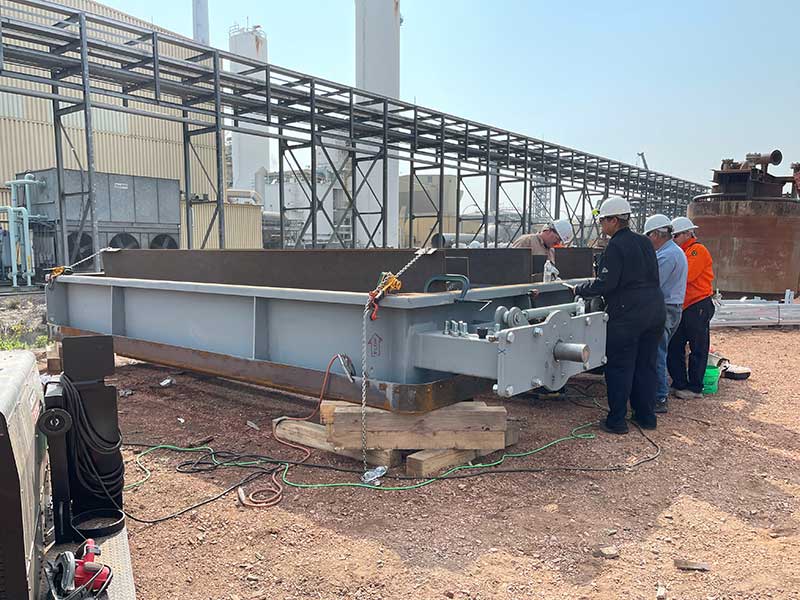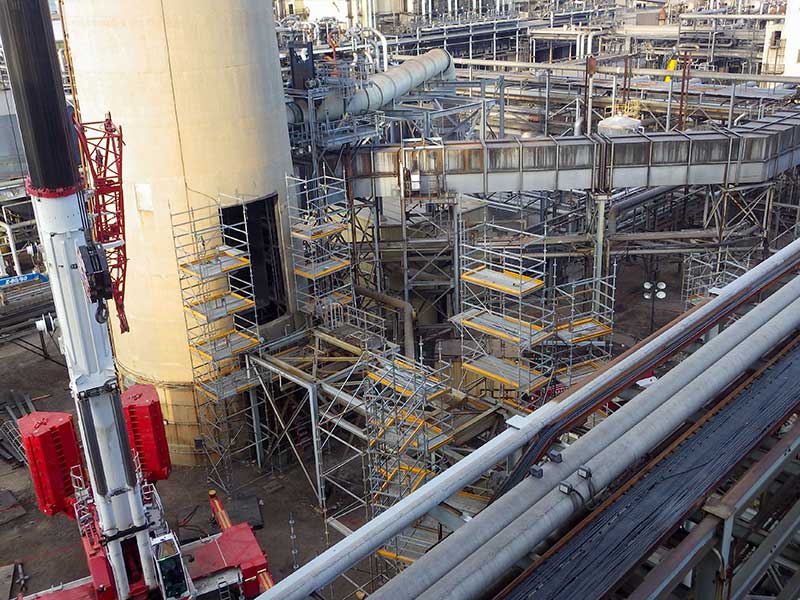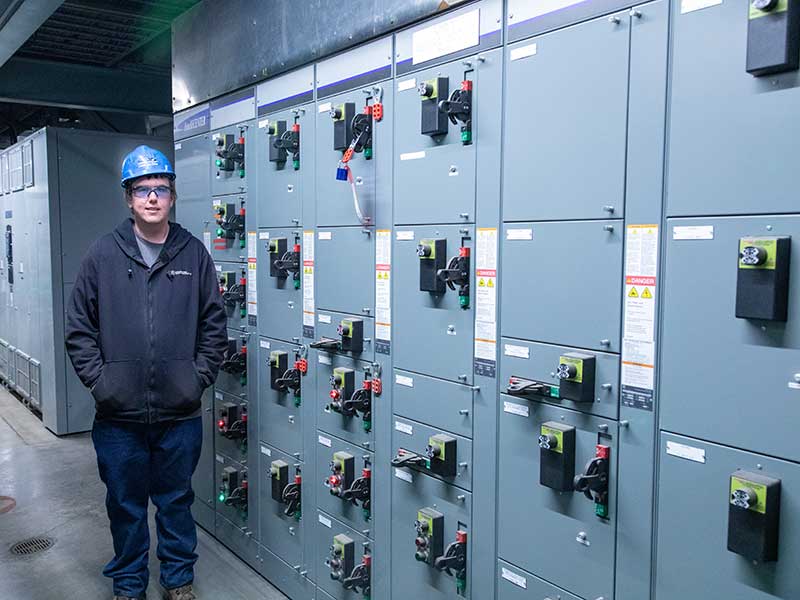- Products
- About us
- Responsibility
- Environment
- News
- Contact us
- Careers
-

For most people, a power outage means having to bring out the candles and keep the refrigerator door shut until the lights come back on. For the crews who work at Dakota Gasification Company’s Great Plains Synfuels Plant, a facility that produces synthetic natural gas, fertilizers, chemicals, and more from the gasification of coal located in Beulah, North Dakota, and Laramie River Station, a coal-based dispatchable generation facility located in Wheatland, Wyoming, an outage is something else entirely.
Basin Electric is committed to providing reliable electricity to its members, and it’s through carefully planned and managed outages at its facilities that maintenance, repairs, and upgrades are completed to help ensure the reliability our members expect.
Scheduled outages play a crucial role in maintaining reliability and efficiency. Just like a race car driver pulls over during a race to receive maintenance, regular maintenance at our plants ensures that Dakota Gas can continue to manufacture products and Laramie River Station can continue generating electricity.
Dakota Gas completed its fall outage activities in October. During this outage, what was scheduled as a “brown” plant outage turned into a “black” plant outage. The fundamental difference is that during a brown plant outage some of the utility systems, including one train of the oxygen plant, would remain in service throughout the outage. Unfortunately, a large motor in the oxygen plant failed about a week into the brown plant outage, so Dakota Gas went black, which lasted for 18 days. The combination of both the brown plant and the black plant outage lasted approximately 35 days. The plant’s nitrogen distribution system remained in service the entire outage, which is critical to safety. While the motor in the oxygen plant was down, nitrogen was purchased from an outside source and delivered by truck.

Historically, all outages provide the chance to make improvements in the plant, but the black plant outage provided a unique opportunity to repair steam systems and utility systems that are common to both trains of the plant. This includes replacing valves that deteriorated over time. In turn, these valves provide isolation for performing various levels of maintenance. This outage included replacing the ductwork and dampers between the boilers and flue gas desulfurization. During a previous boiler outage, the dampers would not close properly, so an additional outage was required to isolate that boiler for maintenance. With the ductwork and dampers repaired, the system will be safer and provide the ability to isolate the boilers when maintenance is required.
“The outage allowed us to perform work on common systems like the steam and cooling piping throughout the plant that are rarely out of service,” Dale Johnson, senior vice president and plant manager at Dakota Gas, says. “For example, there was a large chunk of plastic weighing about 3,000 pounds that was created in a cooling tower fire. This chunk was floating in the cooling tower sump and was damaging the screens on the inlet to the cooling water pumps. This chunk of plastic, plus a bunch of smaller material, was removed from the sump, and this work could only be done during a plant outage.”
During the outage, over 4,000 tasks such as equipment repairs, rebuilds, and replacements were completed throughout the plant. “Going into this outage, I think we were all concerned about the boiler duct replacement project. That was probably the most complex project for this outage, and it went very well,” Johnson says. “The evaporative cooler replacement in the oxygen plant was another large, complex project that went well.”
“Outages in general provide opportunities to repair, replace, or improve process equipment that cannot be maintained during operation; this brings equipment back to where they’re designed to operate or to make equipment improvements, which ultimately improves efficiency and reliability,” Brian Dillman, maintenance manager at Dakota Gas, says. “Proper maintenance is essential to maintain safe and reliable equipment to support production, which supports our members in providing value-added products and revenue streams.”
Facilities like Laramie River Station provide long-term power generation, and that’s why scheduled outages and regular maintenance are so important. They ensure these dispatchable generation facilities operate reliably so members can continue receiving the power they
rely on.

Basin Electric coordinates all outages to make sure there’s no disruption in power. “Our outages are scheduled during the spring and fall months when demand for power is typically lower,” Levi Mickelsen, plant manager at Laramie River Station, says. “Outages are a major effort and require all hands on deck, as well as many contractors who bring technical oversight and additional manpower to help complete the work. During these outages we clean, inspect, repair, and restore the unit to as new of condition as possible, ensuring the unit is available and reliable.”
Laramie River Station, which consists of three coal-based generation units that have the capability of producing up to 1,700 megawatts of dispatchable electricity, is upgrading their 480-volt switchgear, which includes the transformer, the load center, and the motor control center. Dustin Rothe, electrical engineer III at Laramie River, is the site contact and coordinator, helping complete these electrical upgrades at the plant. “Currently, we have long-range engineering plans through at least 2030 for the 480-volt switchgear upgrades for the scrubbers, coal yard, and water treatment areas,” Rothe says. “We will complete the 480-volt switchgear upgrade for the main plant during the 2024 spring outage.”
A brand-new standby load center in Unit 3 was installed a few years ago in preparation for tying into their emergency diesel generator. The standby load center and essential motor control center for Units 1 and 2 have been connected to the emergency diesel generator since the plant was built. “In 2024, we will complete the work to tie the emergency diesel generator to Unit 3,” Rothe says. “The emergency diesel generator will kick on and power the standby load center and essential motor control center to provide power to critical pieces of equipment during a black plant.”
The plant has also added a few new cross-feed connections, providing multiple options to keep the plant running in case of equipment failure or routine maintenance and ensuring continued reliability for Basin Electric’s members.
While scheduled outages are essential for maintaining the reliability of power plants, Dakota Gas and Laramie River Station strive to minimize the duration and frequency of these events to ensure production and a stable electricity supply for members. Advanced planning, coordination, and effective communication are key elements in managing scheduled outages without compromising reliability.
Dakota Gasification Company
Headquarters:
1717 East Interstate Avenue | Bismarck, ND 58503-0564 USA
701.223.0441 | 1.800.242.2372
Great Plains Synfuels Plant
420 County Road 26
Beulah, ND 58523-9400 USA
701-873-2100
A subsidiary of:
Basin Electric wants all interested and qualified candidates to apply for employment opportunities. If you are an applicant with a disability who is unable to use our online tools to search and apply for jobs, or who needs other assistance or accommodations, please contact us at 701-223-0441. Please indicate the specifics of the assistance needed or provide your contact information, and a Basin Electric Human Resources representative will contact you. Basin Electric is an Equal Employment Opportunity Employer regarding race, color, religion, sex, sexual orientation, gender identity, national origin, disability, and veterans status.